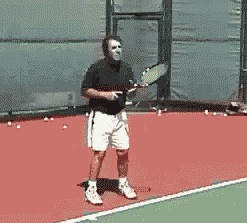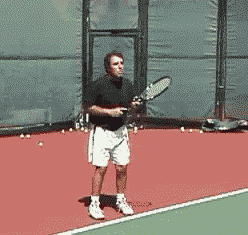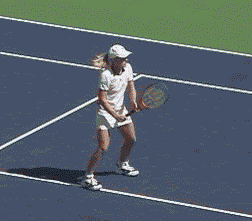|
TennisOne Lessons
First Things First:
|
||||||||||||
|
|
The First Things First series will be a challenge for me as a writer. I hope to convey how certain elements of the game feel, rather than describe how these certain elements work. I hope to avoid analysis and invoke your own memories of actions that resemble the elements we are exploring. Bear with me. I am becoming more and more convinced that the cognitive approach to teaching and learning tennis may actually obscure the development of skills and an approach that calls on kinesthetic feel may actually speed improvement.
So, you are on the baseline, waiting in an excellent ready position. And to digress, this ready position allows you to move quickly, easily, and effortlessly to the ball. And now you see the ball coming to the forehand side - so what occurs? What is your first move?
|
|
From my experience with Tom Stow, I observed the following. He would ask the student to demonstrate the turn (which is in fact the first move).
- If the student turned but lost balance, the lessons would emphasize posture.
- If the student turned but also stepped in, the lessons would begin with the concept of waiting on the back foot.
- If the student turned and tensed the arms, the lessons would focus on relaxation during the first move.
- If the student turned and raised the racquet, the lesson would explore the quieting of the arms during this initial move.
So in all instances, Stow's eye was to carve off all extraneous movement, and to find the essence of the turn. As an aside, Tom did have a sense of humor, if he asked for a demonstration of the turn and the player turned but also stepped in, he would remark caustically, "I only asked for the turn, lets try it again." Or if the player turned and tightened the arms, he might say, "Turn means turn, nothing else, lets try again." Always trying to get more by doing less.
|
|
In the two examples you are viewing, I am tossing underhand to Jay. I told him we would only hit forehands. I told him I was standing close but tossing slowly, so the ball would arrive quickly, but equally the slowness of the toss would create timing problems if he stepped in too soon.
After a sequence of about 5 or 6 tosses, I would toss again but not release the ball; tricking Jay into thinking it was coming. But, and this is important, as he moved then saw there was no ball to hit, we could both examine his posture, his balance, his arms, his elbows or knees, anything that "changed" from their use in the ready position as he began the turn.
In many instances, his first move betrayed a loss of balance, he was tipping forward. In others he had shifted his weight to his left foot in order to move his right foot. And in others, his head slightly tilted. And in every case, he was finding awareness for how it felt when wrong, and how it felt when right.
So how does this turn feel, when done with simplicity, efficiency, and somehow without effort? Imagine yourself standing on the tennis court, relaxed, arms lightly folded and cradling the racquet. At this moment,
not thinking of anything in particular, not trying, not worrying, nothing at all, a friend called out from another court to say hello, (imagine they are calling from your right) your movement to them would be a perfect turn. That is, this turn to look over to them would involve just the minimum amount of movement. Turn and say hello.
|
That is probably more spontaneous than turning to the forehand, but the movements are essentially the same. If you turned to say hello and lost your balance, turned to say hello and stepped in, turned to say hello and flexed your arms, your friend might worry that something may be wrong (as would I).
But somehow these extraneous actions are often typical of the preparatory turn, where effort is introduced because the upcoming task is presumed to be difficult. But the truth is, the upcoming task will become difficult when these extra elements are injected. And the task will be liquid when nothing arises to interfere with this first simple move.
On the court, try the following. When the server hits the tape, or when a groundstroke from the opponent hits the top of the net, note your position. In fact monitor this position each and every time the opponent's (or partner's) shot hits the net. For the ball that hits the net had crossed half the court, taking more or less half the time it would have taken had it arrived, and in this amount of time you may have done something.
- If you hadn't turned at all you are generally late on court.
- If you turned and stepped in, you are generally off time and swinging too early.
- If you turned and jerked your arms up, you generally net the ball.
- And if you turned and did nothing else, you are learning how this first move feels, and it does feel good.
|
|
Once mastered, the backhand turn is identical. The forehand volley turn is identical but slightly smaller, the backhand turn identical to the forehand turn. And the turn with the toss on the serve is again identical to the forehand turn. First things first, the turn.
Recommendation - Click here to view Andy Roddick's forehand (although almost any in the ProStrokes Gallery will do), "Play this sequence noting just his initial turn - that's it!
More is Less!
So how do you internalize the fluid movements of Pros like Agassi and Henin? Try this on court drill - aptly named "Less is More."
Using a ball machine on a gentle setting, or rallying easily from service line to service line with a friend, try hitting forehands (though the same drill works for the backhand or the volley) gently but still squarely. Stow called it the "conk." During this drill, try to move the minimum amount, with minimum tension, but always monitoring the collision, and referencing which ones feel just right and which are somehow mishits or off balance.
Pay attention to your head, your shoulders, and your body weight. Is your vision undisturbed, or does your
head jerk during some swings? Do your shoulders turn back and forth with the preparation and the hit, or are your shoulders either frozen or overactive? Is your body weight placed against the hit, or are you leaning either too far backward or forward? Monitor the quality of each hit, always seeking to do more with less. Stay tuned
Your comments are welcome. Let us know what you think about Jim McLennan's article by emailing us here at TennisONE.
![]()
|
Click here to order. |
The Secrets of World Class Footwork - Featuring Stefan Edberg by Jim McLennan Learn the secret to the quickest start to the ball, and the secret to effortless movement about the court. Includes footage of Stefan Edberg, one of the quickest and most graceful of all the professionals. |
Click here to order. |
|
Learn pattern movements to the volleys, groundstrokes, and split step reactions. Rehearse explosive starts, gliding movements, and build your aerobic endurance. If you are serious about improving your tennis, footwork is the key.
Includes video tape and training manual (pictured above). - $29.95 |
||






